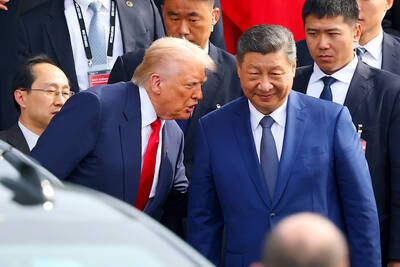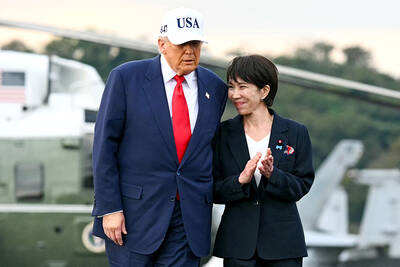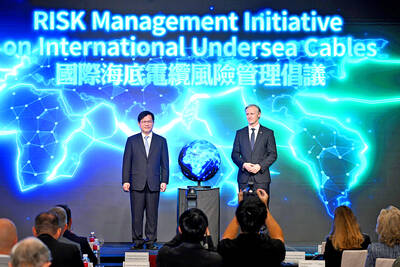South Korean President Lee Myung-bak yesterday urged North Korea to end its military provocations and make a “courageous change” as he laid out a long-term plan for reunification.
“It is about time Pyongyang looked straight at reality, made a courageous change and came up with a drastic decision,” Lee said.
The Koreas “need to overcome the current state of division and proceed with the goal of peaceful reunification,” he said in a speech to celebrate Korea’s liberation from Japanese colonial rule in 1945.
Lee also warned that South Korea would not tolerate any military provocations from North Korea.
“The North must never venture to carry out another provocation nor will we tolerate it if they do so again,” he said.
Cross-border tensions have been high since late May when South Korea and the US accused Pyongyang of attacking a South Korean warship.
The North, which vehemently denies the accusation, threatened retaliation after US and South Korean troops staged naval drills in a show of force.
Relations further worsened after North Korea last weekend seized a South Korean squid fishing boat operating off the east coast.
The North also fired an artillery barrage into waters in the Yellow Sea a week ago when South Korea wrapped up its biggest anti-submarine drill.
In his speech, Lee detailed a multi-step blueprint for reunification, starting with a “peace community” after the peninsula is cleared of nuclear weapons.
The next step is to dramatically develop the North’s economy and form an “economic community in which the two will work for economic integration,” he said.
Finally, the Koreas would be able “to remove the wall of different systems” and establish a community which will ensure “dignity, freedom and basic rights of all individuals,” he said.
REUNIFICATION TAX
“Through this process, we can ultimately bring about the peaceful unification of Korea,” he added.
North Korea didn’t immediately respond to Lee’s reunification proposal, but issued a warning that its military would be “merciless” in its retaliation against joint military exercises planned this week by South Korea and the US.
Lee also proposed a “reunification tax” to help fund the expected US$1 trillion bill when the two Koreas eventually rejoin.
There are no signs that North and South Korea are anywhere near close to reconciliation, with about 1 million soldiers facing off across the Cold War’s last great divide.
“Reunification will definitely come,” Lee said in the speech. “I believe that the time has come to start discussing realistic policies to prepare for that day such as a reunification tax.”
Lee said it was now time to start saving for the massive cost of reuniting with the North, whose economy has been driven close to ruin by central economic planning, heavy military expenditure and years of famine.
North Korea is an economic backwater, with annual GDP of about US$24 billon last year — less than 3 percent the size of the South’s economy.
By some estimates, it would cost more than US$1 trillion to absorb the North.
That could wreak havoc on South Korea’s economy, with a state-funded research agency saying it would raise the tax bill for South Koreans by the equivalent of 2 percentage points annually for 60 years.
Opinion polls, however, show more than 60 percent of South Koreans want unification, but they would prefer it happen later rather than sooner because of the cost.
Lee, who is halfway through his single five-year term, has advocated a hard-line approach toward Pyongyang unlike his liberal predecessors.
RESPONSE TO JAPAN
He has cut aid to a trickle and all but cut off investment in North Korea after Pyongyang conducted a second nuclear test and test-fired long range missiles last year.
In his biggest Cabinet reshuffle a week ago, Lee kept his foreign, defense and unification ministers in place, signaling little change in his policy.
Lee welcomed Japan’s efforts to improve ties, but said some issues had yet to be resolved.
“I have taken note of Japan’s effort, which represents one step forward,” he said.
Japanese Prime Minister Naoto Kan, who has sought stronger ties with South Korea, issued a fresh apology on Tuesday for colonial rule and promised to hand over precious Korean cultural artifacts.
Lee praised Kan for issuing an apology.
“However, there still remain issues that have to be resolved. The two countries are called upon to take concrete measures to forge a new relationship for another 100 years,” he said, without elaborating.
The two countries normalized relations in 1965, but Japan has often been criticized by its neighbors for glossing over wartime atrocities.
Also See: US, S Korea plan second exercise

CALL FOR SUPPORT: President William Lai called on lawmakers across party lines to ensure the livelihood of Taiwanese and that national security is protected President William Lai (賴清德) yesterday called for bipartisan support for Taiwan’s investment in self-defense capabilities at the christening and launch of two coast guard vessels at CSBC Corp, Taiwan’s (台灣國際造船) shipyard in Kaohsiung. The Taipei (台北) is the fourth and final ship of the Chiayi-class offshore patrol vessels, and the Siraya (西拉雅) is the Coast Guard Administration’s (CGA) first-ever ocean patrol vessel, the government said. The Taipei is the fourth and final ship of the Chiayi-class offshore patrol vessels with a displacement of about 4,000 tonnes, Lai said. This ship class was ordered as a result of former president Tsai Ing-wen’s (蔡英文) 2018

UKRAINE, NVIDIA: The US leader said the subject of Russia’s war had come up ‘very strongly,’ while Jenson Huang was hoping that the conversation was good Chinese President Xi Jinping (習近平) and US President Donald Trump had differing takes following their meeting in Busan, South Korea, yesterday. Xi said that the two sides should complete follow-up work as soon as possible to deliver tangible results that would provide “peace of mind” to China, the US and the rest of the world, while Trump hailed the “great success” of the talks. The two discussed trade, including a deal to reduce tariffs slapped on China for its role in the fentanyl trade, as well as cooperation in ending the war in Ukraine, among other issues, but they did not mention

Japanese Prime Minister Sanae Takaichi yesterday lavished US President Donald Trump with praise and vows of a “golden age” of ties on his visit to Tokyo, before inking a deal with Washington aimed at securing critical minerals. Takaichi — Japan’s first female prime minister — pulled out all the stops for Trump in her opening test on the international stage and even announced that she would nominate him for a Nobel Peace Prize, the White House said. Trump has become increasingly focused on the Nobel since his return to power in January and claims to have ended several conflicts around the world,

GLOBAL PROJECT: Underseas cables ‘are the nervous system of democratic connectivity,’ which is under stress, Member of the European Parliament Rihards Kols said The government yesterday launched an initiative to promote global cooperation on improved security of undersea cables, following reported disruptions of such cables near Taiwan and around the world. The Management Initiative on International Undersea Cables aims to “bring together stakeholders, align standards, promote best practices and turn shared concerns into beneficial cooperation,” Minister of Foreign Affairs Lin Chia-lung (林佳龍) said at a seminar in Taipei. The project would be known as “RISK,” an acronym for risk mitigation, information sharing, systemic reform and knowledge building, he said at the seminar, titled “Taiwan-Europe Subsea Cable Security Cooperation Forum.” Taiwan sits at a vital junction on